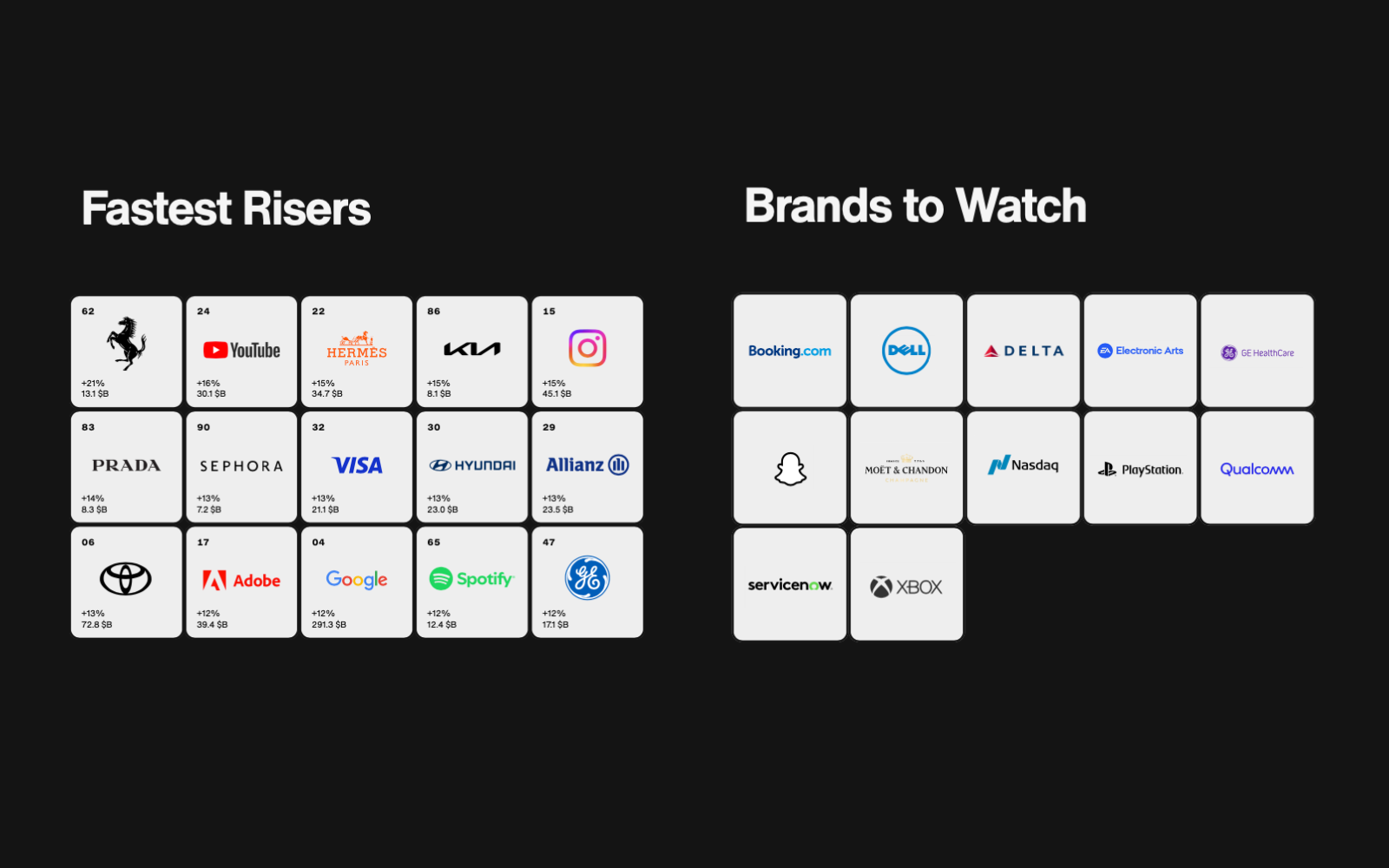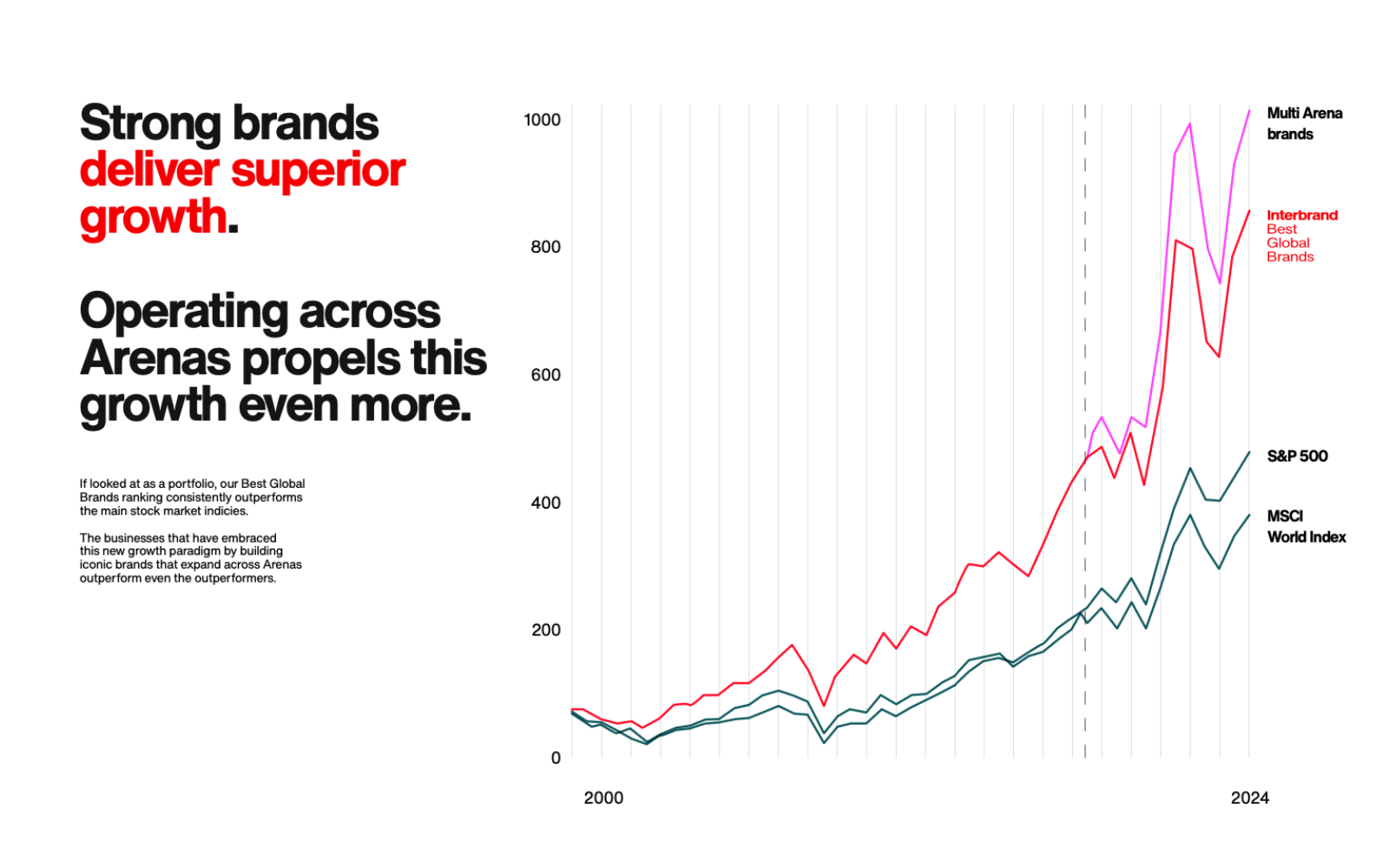A few days ago, global brand consultancy Interbrand unveiled its 25th Top 100 Best Global Brands ranking and report.
The report features a list of the top 100 brands worldwide and key insights shaping the branding industry. Here are our five favorite takeaways from the report.
Please note that this article is independent of Interbrand; our intention is to share valuable insights that could benefit branding professionals.
Proven Systems for Business Owners, Marketers, and Agencies
→ Our mini-course helps you audit and refine an existing brand in 15 days, just 15 minutes a day.
→ The Ultimate Brand Building System is your step-by-step blueprint to building and scaling powerful brands from scratch.
Table of Contents
Which brands made it to the top 25 list?

According to Interbrand, the top 25 most valuable brands in 2024 are: Apple, Microsoft, Amazon, Google, Samsung, Toyota, Coca-Cola, Mercedes-Benz, McDonald’s, BMW, Louis Vuitton, Tesla, Cisco, Nike, Instagram, Disney, Adobe, Oracle, IBM, SAP, Facebook, Hermès, Chanel, YouTube, and J.P. Morgan.
The report also highlights the brands to watch, the fast risers, as well as the new entrants to the ranking.

To establish its rankings, Interbrand relies on a three-pillar methodology:
- Financial Forecast: This measures the economic return that the brand generates for its investors or its economic profit.
- Role of Brand: This indicator assesses the brand’s influence on consumer purchasing decisions as opposed to other marketing factors (for example: price, product features).
- Brand Strength: This aspect examines a brand’s ability to create loyalty and sustain ongoing demand in the future.
Insight #1: The increased focus on short-term performance marketing has cost brands trillions
By prioritizing performance marketing over long-term brand investment, the world’s most valuable brands have lost approximately $3.5 trillion in cumulative brand value.
“Utilizing our Best Global Brands data, we see that an increased focus on operational efficiency and short-term performance tactics over mid-term and long-term brand potential has cost the world’s most valuable brands $3.5 trillion USD in cumulative brand value since we started our study. This equates to approximately $200 billion of lost revenue opportunity over the past 12 months.”
Source: Interbrand
Insight #2: The branding landscape is navigating a completely new terrain
The competitive landscape has changed a lot from the past when businesses experienced long periods of stability between disruptions. Now, disruptions happen all the time, creating an environment that is in perpetual motion and uncertain.
“We used to think of the competitive environment as one of punctuated equilibrium, where there were long periods of stability between disruptions. Now the disruptions are coming closer and closer together. The competitive environment is in perpetual motion…”
Professor Rita McGrath,
Columbia Business School
While the basic rules of branding are still the same, the way things work has transformed. Here are some of the key ideas highlighted in the report:
— Consumers have more choices than ever, making it easy and cheap to explore new options, even if they already like a brand.
— Innovation increases and gets adopted very quickly
— Feedback loops between brands and their consumers are now instant and consistent thanks to smart data use and artificial intelligence
— In this new world, a business, its brand, and its leaders are closely connected
— Societal leadership is now an important part of a business’s role.
— Anyone with a smartphone can build a brand, making branding and brand management more mainstream than ever
— Brands need to understand that they are not just sending out messages anymore; they are having real conversations with their audiences.
Insight #3: Competing on product and price alone belongs to the past. Today the brand is the true differentiator.
The product brand is not enough anymore. If businesses and organizations want to truly stand out, they can’t rely solely on product features, prices, or location. This is because today, customers can easily find similar products at competitive prices.
In today’s context, the brand becomes the most important factor that sets a business apart. It’s the one asset that cannot be easily and legally replicated.
“Now, when a business competes on product, price or proximity, advantages are increasingly temporary. Product features and benefits can be copied. Technologies are easy to acquire. Discounting and couponing can only drive short term uplift and competing exclusively on price dilutes long-term loyalty, driving commoditization. Proximity? It matters less in a supply chain that can distribute almost any product to your door within 24 hours. In this context, the brand becomes the only truly ownable point of difference—the one asset that cannot be legally replicated.”
Insight #4: The five ingredients for creating brands people desire
Some brands are just things people buy out of commodity, while others are brands that people deeply desire.
So, how do you make people truly desire your brand? According to Interbrand, the secret relies on creating deep connections with people on different levels—sensory, functional, emotional, personal, and even moral. Brands that connect with people in these five ways have the potential to become iconic. The ultimate objective? Making people recognize the brand, enjoy it, and want to see what they do next.
Insight #5: The most successful brands (called Multi Arena brands) are growing through several product categories

In 2024, the top brands globally have established themselves in various competitive arenas that go beyond the traditional industry or product category. Companies like Apple, Ferrari, and Disney shift their positioning from “here’s what we do” to “here’s what we can help you do”. They navigate through different product categories that can achieve this goal.
“When we map the top 25 brands in our Best Global Brands table, we see a significant number of companies that deploy their brand in different ways to traditional category incumbents, unlocking exponential pathways to growth.”
This doesn’t mean that all brands should be present in several industries. However, they should position themselves based on needs rather than categories.
This is not a new concept, but it represents the main success factor shared by today’s top global brands.
Conclusion
If there is one main takeaway from this 2024 ranking and report, it’s that the most successful companies are not just promoting their products and services. Instead, they are letting their brands guide their entire business strategy.
Link to the full report: Interbrand’s 2024 Top 100 Best Global Brands Report








